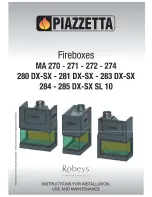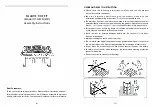
17.5 To remove the gas valve.
(See figure 38).
1.
Remove the burner unit
(See section 17.3).
2.
If lying the burner on its
back, ensure that the work
surface is suitably protected.
This will avoid damage to
the work surface. Turn the
burner unit upside down.
Detach the thermocouple
from the tap.
3.
Detach the pilot pipe from
the tap.
4.
Detach the inlet pipe.
5. Detach the injector pipe
6.
Detach the electrode lead
from the base of the
electrode.
7.
Remove the control knob by pulling forward.
8.
Remove the thermocouple by unscrewing the thermocouple nut at the gas valve.
9.
Remove the hexagonal nut securing the gas valve to the mounting bracket.
10.
Remove the gas valve.
11.
Refit in the reverse order.
17.6 To remove the piezo generator.
1.
Remove the gas valve as section 17.5.
2.
Make sure that the tap is in the off position.
3.
Remove the circlip holding the piezo unit to the tap. Remove the piezo unit.
4.
Replace in the reverse order.
17.7 To grease the control tap.
1.
Detach the gas valve and remove the piezo generator as section 17.6 making sure
that the valve is in the off position.
2.
Remove the two screws from the head of the valve. Remove the niting head and
spindle complete with collar and spring.
3.
Note the position of the slot in the plug-mark its position on the valve body.
4.
Remove the plug rotating slightly while pulling.
5.
Clean and grease the plug lightly with suitable grease. Do not apply excessive
grease. Particularly, make sure that the gas ports in the valve are not restricted by
grease.
Page 33
INSTALLER GUIDE
Figure 38. Gas valve (Viewed from rear
with burner turned over)


































